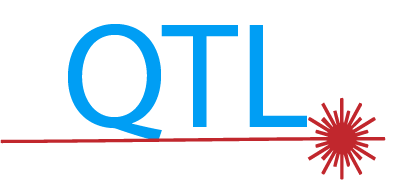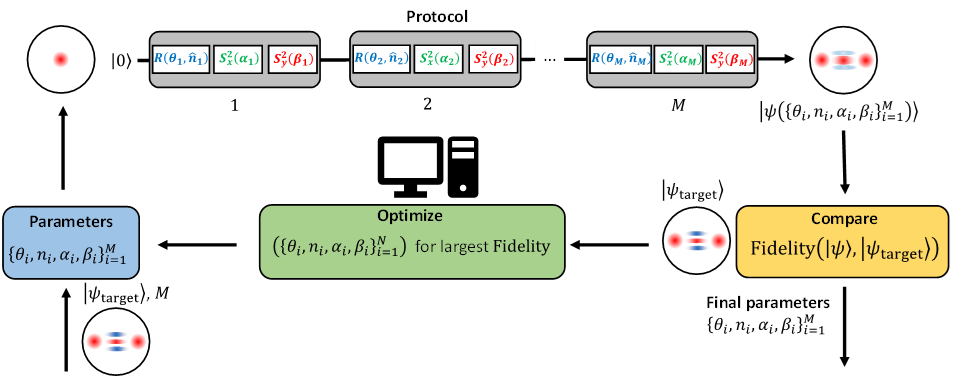
Quantum Technology Lab (QTL)
Our laboratory offers research projects combining theory and experiment.
The research deals with ultrafast light and matter interactions as a basis for quantum technologies such as metrology and quantum computing.
Projects manager: Shiran Even-Haim shiranev@campus.technion.ac.il
Simulating conditional displacement and GKP state with the IBM quantum computer
In this project, we will write a program that simulates continuous variable quantum computation using the IBM quantum computer's discrete system. We will simulate the conditional displacement gate and create an approximate GKP state of many qubits. We will investigate the limits of discrete to continuum and study the analogy between a quantum walk in discrete variables and the conditional displacement gate in continuous variables.
LabAdmin link: https://labadmin.ef.technion.ac.il/prj/project/view/ProjectId/7759
Key concepts: IBM quantum computer, GKP, conditional displacement, continuous variable quantum computation, quantum walk
Further reading:
- G. Baranes†, S. Even-Haim†, R. Ruimy†, A. Gorlach, R. Dahan, A. A. Diringer, S. Hacohen-Gourgy, and I. Kaminer, Free-electron interactions with photonic GKP states: universal control and quantum error correction, Phys. Rev. Res. 5, 043271 (2023)
Prerequisite: Modern quantum computing course 047006/046054 (studying the course while doing the project is okay)
Contact: Shiran Even-Haim shiranev@campus.technion.ac.il
Measuring super-radiance and quantum properties of nano-emitters
In this project, we will investigate the unique properties of electromagnetic radiation emitted from different nanometer emitters excited by free electrons. These features include the photon statistics, the coherence of the radiation, and its spectrum. In addition, we will delve into super-radiance, which is the radiation created when there are many exciters (free electrons) or emitters acting together coherently.
LabAdmin link: https://labadmin.ef.technion.ac.il/prj/project/view/ProjectId/7714
Key concepts: Photon statistics, cathodoluminescence, superradiance
Further reading:
- R. Ruimy†, A. Gorlach†, G. Baranes, and I. Kaminer, Superradiant Electron Energy Loss Spectroscopy, Nano Lett. 23, 779−787 (2023) (Supplementary material)
- A. Gorlach†, O., A. Pizzi†, R. Ruimy†, G. Baranes, N. Rivera, and I. Kaminer, Double-superradiant cathodoluminescence, Phys. Rev. A 109, 023722 (2024)
Contact: Yuval Adib yuvalad12@gmail.com
EM field tomography in 2D materials and plasmonic devices
In this project, we will deal with the development of innovative methods for measuring the electromagnetic field in a complete vector manner, that is, direct measurement of all the components of the field. Using these methods, we are interested in investigating two-dimensional materials (materials made of a single number of atomic layers). In these materials, fundamental physical questions surround the way electromagnetic waves travel on the surface. Another direction of research is vector optical mods called Skyrmions, which exist in devices based on the interaction of light with the surface of a metal (plasmonic devices).
LabAdmin link: https://labadmin.ef.technion.ac.il/prj/project/view/ProjectId/7725
Key concepts: EM field tomography, 2D hyperbolic materials, optical skyrmions
Further reading:
- T. Fishman†, U. Haeusler†, R. Dahan, M. Yannai, Y. Adiv, T. Lenkiewicz Abudi, R. Shiloh, O. Eyal, P. Yousefi, G. Eisenstein, P. Hommelhoff, and I. Kaminer, Imaging the optical field inside nanophotonic devices, Nature Commun. 14, 3687 (2023) (Supplementary material)
Contact: Tal Fishman ftal@ef.technion.ac.il
Design and measurement of THz sources for electron beam shaping and control
In this project, we will develop and characterize laser-pumped sources for generating short electromagnetic pulses in the terahertz range. These sources and the emitted radiation are used to shape the electron beam in the microscope, emphasizing the creation of short/monochromatic electron pulses. We will explore new experiments made possible by these pulses, such as quantum random walk.
LabAdmin link: https://labadmin.ef.technion.ac.il/prj/project/view/ProjectId/7726
Key concepts: Electron monochromation, electron phase-space manipulations
Further reading:
- M. Yannai†, Y. Adiv†, R. Dahan†, K. Wang, A. Gorlach, N. Rivera, T. Fishman, M. Krueger, and I. Kaminer, Lossless Monochromator in an Ultrafast Electron Microscope Using Near-field THz Radiation, Phys. Rev. Lett. 131, 145002 (2023)
Contact: Michael Yannai yannai.michael@gmail.com
Probabilistic Shortest Path Algorithm for Quantum Communication
LabAdmin link: https://labadmin.ef.technion.ac.il/prj/project/view/ProjectId/7812
Key concepts: Random graphs, quantum communication, shortest path algorithms
Further reading:
-
Di Franco, Carlo, and D. Ballester, Optimal path for a quantum teleportation protocol in entangled networks, Phys. Rev.A 85, 010303 (2012)
Prerequisite:
- required courses: 44268 - מבוא למבני נתונים ואלגוריתמים or equivalent. Any course in quantum information
- suggested courses: 46002 - תכן וניתוח אלגוריתמים or equivalent
Contact: Nir Gutman nirgutman212@campus.technion.ac.il

LabAdmin link: https://labadmin.ef.technion.ac.il/prj/project/view/ProjectId/7813
Key concepts: Quantum Universality, Quantum circuits, Quantum noise channels, Machine Learning
Further reading:
- N. Gutman†, A. Gorlach†, O. Tziperman, R. Ruimy, and I. Kaminer, Universal Control of Symmetric States Using Spin Squeezing, Phys. Rev. Lett. 132, 153601 (2024)
- Required courses: Any course in quantum computation/algorithms/technology
- Ability to write good-quality code in python
- Experience with a Deep Neural Network tool. Preferably in python
- Good to have: Some familiarity with core concepts in quantum information

Prerequisite: Modern quantum computing course 047006/046054 (studying the course while doing the project is okay)
In this project, we will design and analyze a novel quantum-optical tomography device. Current methods to analyze the quantum state of light are either robust to noise and loss, but are not able to fully resolve the state, or are very sensitive to loss, but provide the complete state of light. In this project, students will:
- Combine aspects of both types of devices in order to create a robust and complete quantum analysis (tomography) device.
- Write a theoretical analysis and a simulation of the device, in order to find the practical capabilities and limitations of the proposed device in terms of losses, dynamic range and bandwidth.
- Outline a practical design of the device to be built during following projects.: In this project, we will design and analyze a novel quantum-optical tomography device. Current methods to analyze the quantum state of light are either robust to noise and loss, but are not able to fully resolve the state, or are very sensitive to loss, but provide the complete state of light. In this project, students will:
- Combine aspects of both types of devices in order to create a robust and complete quantum analysis (tomography) device.
- Write a theoretical analysis and a simulation of the device, in order to find the practical capabilities and limitations of the proposed device in terms of losses, dynamic range and bandwidth.
- Outline a practical design of the device to be built during following projects.
Goal:
Design and construct a femtosecond ultraviolet (UV) laser pulse compressor, and integrate it into the ultrafast TEM (UTEM) lab optical setup.
Technological gap:
The current optical design uses a Carbide laser (Light Conversion, 1030 nm, 1 MHz rep. rate), which is up-converted to the 4th harmonic (256 nm). This generates transform limited pulses of about 250 fs FWHM.
Observing quantum electron optics phenomena and simultaneously achieving record-high temporal and energy resolution necessitates the use of much shorter UV pulses (down to 5-10 fs).
Critical steps:
- Literature survey:
- Ultrafast optics basics: Ultrafast lasers, harmonic generation, parametric amplification, dispersion and chirp, dispersion compensation, grating and prism compressors.
- Existing techniques for UV pulse compression: (i) multi-pass cell (MPC) (ii) gas-filled fiber. (iii) Anything else?
- Compare the existing compression techniques and suggest a conceptual design for each that fits with the existing setup and lab requirements.
- Select a design to be realized using the following criteria (partial list): required time and budget, design complexity, space allocation on the optical bench, number of required changes to the existing setup, interference with other modules in the setup, etc.
- Simulate the chosen solution using a numerical tool (3D+1 beam propagation method or BPM).
- Detailed optical design using a CAD tool (g. SolidWorks).
- Select appropriate vendors and order components.
- Construct the compressor, characterize the performance and optimize.
Setup
The setup consists of the following components:
- X-ray source
- Sample (like a bug) (we assume an amplitude mask)
- Scintillator (X-ray -> visible light)
- Optical setup (lenses, distances, etc)
- Pixelized detector (of visible light)
The X-ray source hits the sample which attenuates the X-ray light as a transverse amplitude mask. The sample is attached to a scintillator, which transforms the X-ray light to visible light. The visible light goes through an optical setup and then to a detector.
Project phases
- Design the optical setup of 3D (transverse and depth) and imaging
- Including recommending which optical components to use. For example – focal lengths, NAs, distances, maybe filters and apertures, etc.
- Optimize the scintillation – which scintillator and x-ray energy
- Full simulation of the entire process
- Experiment – if time permits
Phase 1 – optical setup
To complete this phase:
- Construct a theory / simulation that calculates the PSF of a given optical setup (microscope). The emitter is assumed to be a single-wavelength spherical 3D emitter of radius .
- What happens if the emitter is of dimensions and not spherical?
- Optimize the optical setup for XY imaging and for Z imaging (depth from defocus).
Concretely, compare the following two realizations and find out which is better
- A 2-lens (4-f system) microscope
- Microscope with an objective lens (commercial -> complex optical system that acts as a corrected lens)
Currently, we use “depth from defocus” as the method for Z-imaging. Depth from defocus uses the fact that the PSF of an object under an imaging system depends on its location relative to the focal plane. This method can be improved / replaced, depending on our findings.
Phase 2 – optimize scintillation
Optimize the choice of scintillator and energy of xray source to get optimal emitter size and resolution in XY and Z.
To complete this phase:
- Construct a simulation (using existing engine by CERN – Geant4) that finds the effective emitter size and characteristics from the scintillator type and incoming X-ray energy
- Optimize the emitter size based on realistic scintillators (and maybe “dream-like” scintillators)
Phase 3 – complete simulation
The goal is to construct a full simulation of the experiment
- Input: scintillator, X-ray energy, sample shape, optical setup
- Output: predicted output of experiments
Stages (and software components):
- Construct probability distribution of emitter location and size
- Calculate the PSF of the optical setup, and use it to construct the probability distribution of the light on the detector
- Using realistic measurement constraints (losses, count rates, etc), simulate the experiment progression.
Phase 4 – ultimate fun – experiment / hard-core optimization
Depending on the results from Phase 1 and 2, and the simulation from Phase 3, there are several possible good directions.
One direction is to design and perform the experiment 🙂
Another direction is to use more advanced tools to optimize the superresolution. For example:
- Optimizing the resolution using non-trivial optical elements and non-trivial designs
- Optimize the scintillator using non-trivial nano-photonic design (layers, disorder)
- Optimize the data acquisition / analysis using non-trivial signal processing
Contact: Chen Mechel chen0908@gmail.com
Quantum computing is a multidisciplinary field at the intersection of computer science, physics, and mathematics that seeks to use the information processing power of quantum mechanics to solve otherwise difficult computational problems. The goal of this project is to generate a quantum computing algorithm that can be put into practice to help solve a real-world challenge.
We will look into phase contrast x-ray imaging. As x-rays behave differently than other radiations, we cannot use "normal" phase contrast approaches. Therefore, the mains approaches are Talbot interferometry and ptychography.
Literature:
• For Talbot interferometry, please look at the note, which explains well the theory. As for ptychography, there is a lot of information online.
• The basic concepts are presented in the first chapter.
In this project, we will plan and create an ultrafast pulsed light source with quantum properties, to be used as an excitation for samples in the Ultrafast Transmission Electron Microscope (UTEM) of the AdQuanta group. The quantum-optical excitation will then be probed by a following electron pulse in order to explore interaction and correlation structures in the samples.


